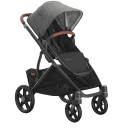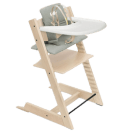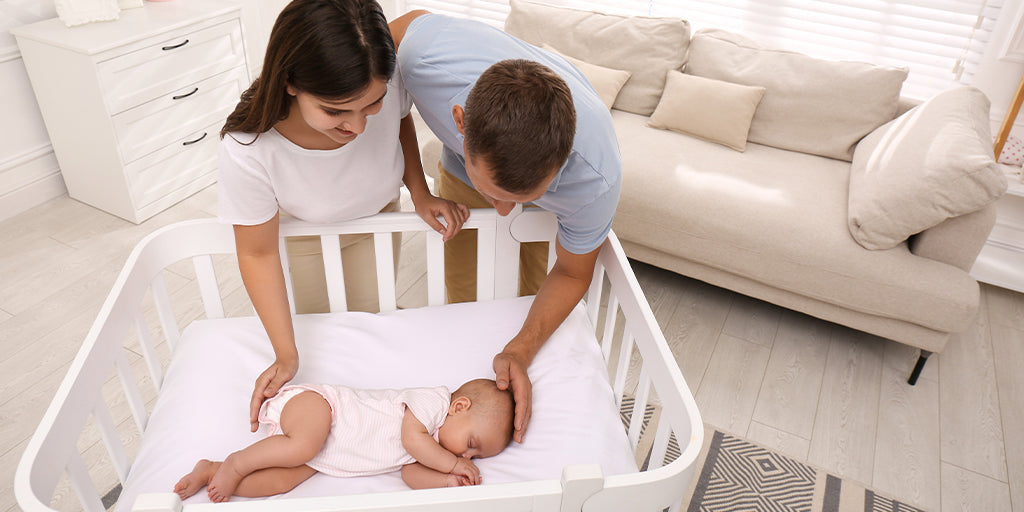Ever caught yourself staring at your baby’s nursery, overwhelmed by where even to begin cleaning? You’re not alone. A neat and orderly nursery is essential for your baby’s health (and your peace of mind—serenity now!). We’ll guide you through a straightforward, step-by-step approach to making your baby’s nursery sparkle.
Start with Decluttering
Do yourself a favor before rounding up the cleaning supplies and start decluttering. You know how it goes: Life as a parent gets (and stays) busy, and before you know it, the nursery starts to collect a little bit of everything. Laundry waiting to be folded, a stray coffee cup, leftover snack wrappers from marathon nursing sessions—the list goes on. And on.
So, start with a game plan. Grab an empty laundry basket and a trash bag, go through the room, and scoop up anything that doesn’t belong in the nursery. Organize your baby’s toys, books, and clothes, setting aside any items your baby has outgrown for donation.
Decluttering may seem like a small step, but it makes the actual cleaning so much easier. Instead of simply shifting piles of stuff around the room, you can roll up your sleeves and get down to it.
Focus on the Crib
Considering how much time your little one spends in the crib, keeping it clean is essential. First, tackle the bedding: Sheets, mattress pads and covers, blankets, and lovies need a bath in something gentle and kind to your baby’s sensitive skin. Opt for a hypoallergenic detergent that thoroughly cleans without harsh chemicals, dyes, and fragrances.
Plan to launder any crib linens weekly or after diaper blowouts or spit-up mishaps (keeping a few clean sheets folded and handy will make the process seamless). And if your little one has had a cold or any other bug, washing them on the sanitize cycle is a good idea.
For the crib, choose an eco-friendly cleaner that’s tough on dirt and grime but gentle enough to leave behind a safe, residue-free surface. Wipe down every slat, corner, and curve, paying special attention to the areas where your baby’s curious hands and mouth might explore.
Tackle the Changing Area
Dirty diapers are more than just unpleasant to your nose—they harbor nasty bacteria and other pathogens that pose health risks if not properly managed. Opt for a reliable diaper pail designed to seal in odor and that can be operated with one hand (because sometimes, that’s all you have free). Frequent emptying and sanitizing of the pail will minimize the risk of germ build-up and keep the nursery smelling fresh.
The diaper changing station itself requires pretty diligent hygiene practices, just like any household bathroom space. This high-traffic area is prone to becoming a hotspot for germs, especially following those all-too-familiar, particularly messy changes. Regularly disinfecting the changing table and any nearby surfaces safeguards the health of you and your kiddo. Utilize a safe, effective disinfectant that’s tough on germs but gentle enough for frequent use in your baby’s environment.
Floor Care
As your baby transitions to a crawler and then a walker, every inch of your floor is a potential playground, and ensuring it’s clean is crucial for their safety and well-being.
Carpets and rugs are primetime play spots where your little one will spend hours rolling, playing, and taking their first steps. But these plush surfaces can also attract dust, allergens, and pulverized Cheerios. Vacuum thoroughly at least once a week—regular vacuuming not only keeps the carpet clean but also maintains a healthier environment by reducing allergens. Microfiber mops are great at picking up dirt and grime off hard floors without excessive water or chemicals, leaving your floors dry and ready for playtime.
Surfaces and Dusting
Dust, that ever-present house guest, finds its way into even the most meticulously kept homes. Made up of a mix that might make you squirm—think skin cells, strands of hair, fabric fibers, and dirt—dust is more than just an eyesore. For babies and their caretakers, it can be an irritant, potentially leading to allergies and breathing problems.
Start at the top and work your way down. Ceiling fans, light fixtures, and the tops of wardrobes or shelves often go unnoticed until a stray beam of sunlight reveals the dust bunnies lurking there. Using a microfiber cloth or a duster with an extendable handle can make this task efficient and (oddly) satisfying. These tools are excellent at trapping dust instead of just moving it around, ensuring that those particles aren’t left floating in the air.
Toy Sanitation
Babies and toddlers are willing to put just about anything in their mouths, so every toy is a potential teether. Little explorers love a curious taste test, so these tiny treasures often become magnets for drool, spills, and the occasional snack residue. A regular toy-cleaning routine is essential to fend off germs and keep sniffles at a minimum.
Most stuffed animal BFFs can endure a gentle cycle in the washing machine—just place them in a pillowcase or laundry bag to prevent damage. For equally quick sanitizing of plastic toys, put them in the top rack of your dishwasher and run the hot cycle (allow them to air dry to prevent warping). And if you’d like to do a deep clean on the bath and other well-loved plastic items, soak them in distilled white vinegar for a few hours before giving them a good rinse.
Organize Regularly
Embracing regular organization in the nursery doesn’t just pave the way for a tidier room—it helps maintain smoother routines and will ultimately save time (you know exactly where that block set is stored).
Imagine a nursery where every toy, storybook, and onesie has its own designated spot. Sounds like an impossible dream? It’s achievable by weaving light organization into your daily routine. Just as you might read a bedtime story or sing a lullaby, putting items back in their rightful place after use can become an integral part of your day. This simple habit cuts down on clutter and makes those middle-of-the-night feeds less of an obstacle course.
The key to maintaining an organized nursery is creating and adapting systems that fit your family’s rhythm. Utilize baskets, bins, and shelves to categorize essentials by their purpose or by how often they’re used. Adopting clear labels can not only guide you, but also other caregivers in keeping the nursery in tip-top shape.
As your baby blossoms into a toddler and “big” kid, their needs and the nursery’s role in their life will evolve. Toys, books, and even furniture will change as they grow. Regular reevaluation of the nursery’s organization will ensure it continues to work for your little one’s age and stage. This might mean transitioning from diaper stations to more accessible bookshelves or toy storage solutions that encourage self-directed play and learning.
Safety Checks
Prioritizing safety transforms the nursery from a simple space into a secure spot where your baby can explore, play, and rest without worry. (And give you time to grab a snack.) Incorporate safety checks into your cleaning routine to ensure that the nursery remains safe and secure. Examine furniture, like cribs or changing tables for wobbly legs or loose hardware, and double check it’s still anchored to the wall to prevent tipping accidents.
Keep cords electrical wires out of reach to eliminate strangulation hazards, and use covers on any exposed outlets. Organize the space so that everything your baby or toddler needs is easily accessible—open cubbies and bins are ideal—yet off-limit items, like diapering essentials or choking hazards, are securely stored away.
Encourage everyone in the home to be mindful of safety, from securing gates to keeping small objects out of reach. A safe nursery is the heart of a happy, worry-free home, creating an inviting space for countless memories and milestones to come.
Include Your Little One
Involving your little one in simple cleaning routines as they grow is not just about keeping their nursery tidy—it’s about laying the foundation for a lifetime of good habits and a sense of personal responsibility. At Albee Baby, we understand that every moment with your tyke is an opportunity for learning and bonding, and integrating them into the up keep of their space is a wonderful way to cultivate these values from the earliest stages.
Begin with small, age-appropriate tasks that your kiddo can feel successful completing independently. For toddlers, it might mean putting toys back into a bin or helping to wipe down surfaces with a safe, baby-friendly cloth. The key is to make these activities engaging and fun, turning cleaning into a game rather than a chore. Celebrate their efforts with plenty of praise and encouragement, reinforcing the positive aspects of tidiness and organization.
Incorporating these tasks into your daily or weekly routines helps to establish a rhythm and expectation. Consistency is essential, as it helps your child understand that taking care of their home is a regular part of life. Use visual cues, like a chart or pictures, to remind them of their tasks, and be patient as they learn to include these habits into their play and daily activities.
Children are incredibly observant, mirroring the actions and attitudes of their caregivers. By involving yourself in the same cleaning routines, showing enthusiasm and diligence, you set a powerful example. Let your kiddo see you tidying up, and explain why it’s important to keep our spaces clean and organized. It teaches them about responsibility and taking pride in their belongings. This ownership encourages them to maintain order and treat their room and belongings with respect. It’s about creating a shared responsibility that contributes to the upkeep of your household.
Prepare for Mess
Navigating the (gorgeous?) chaos of parenthood means accepting that, despite our best efforts, mess is an inevitable companion to the joys and challenges of raising a baby. The pristine nursery you meticulously organized will also host life’s less tidy moments. Blowouts, spit-ups, and temper tantrums can transform a calm space into a minefield of toys, clothes, and the odd mystery stain. But the “mess” is just the hallmark of a space well-lived and loved in. We know that being prepared for these inevitable moments doesn’t just make clean-up easier—it preserves your sanity and allows you to embrace the mess with grace and humor.
One practical tip for staying one step ahead of the chaos is creating a baby clean-up kit. Keeping a basket or bin of basic, baby-safe cleaning supplies within arm’s reach can be a game-changer. Keep a roll of paper towels, a spray bottle filled with water or a gentle, non-toxic cleaning solution, and a stack of extra burp cloths at your disposal for when disaster strikes.
By preparing for the messy moments, you’re not just keeping your nursery in order; you’re also cultivating an environment where you can focus on what truly matters—being present for your little one, mess and all. The clean-up kit is a simple, yet effective way to ensure that you’re ready for whatever comes your way, allowing you to greet each day with confidence, preparedness, and a healthy dose of parental pragmatism. Embrace your inner Type-A personality.
Read more:
- Parent Hack: How to Organize Baby Clothes
- 30 Age-Appropriate Chores for Your Toddler
- Babyproofing 101: A Checklist for Every Room
Finding What’s Right for You
Albee Baby is the oldest family-owned specialty baby shop in the US, and we pride ourselves on providing our customers with the best assortment of baby products anywhere, at fair prices, always. We’re committed to being an inclusive resource for parents and hope you feel empowered to find the right baby gear for your family. Still have questions? Feel free to contact our baby gear experts at 877.692.5233 or info@albeebaby.com.
 Car Seat Sale
Car Seat Sale
 Stroller Sale
Stroller Sale
 Home Sale
Home Sale
 Feeding Sale
Feeding Sale
 Activity & Entertainment Sale
Activity & Entertainment Sale
 Bath & Potty Sale
Bath & Potty Sale






 Car Seats
>
Car Seats
>
 Strollers
>
Strollers
>
 Cribs
Cribs
 High Chairs
High Chairs
 Baby Carriers
Baby Carriers
 Travel Cribs & Playards
Travel Cribs & Playards
 Wagons
Wagons
 Home
>
Home
>
 Bath & Potty
>
Bath & Potty
>
 Diaper Bags & Backpacks
Diaper Bags & Backpacks
 Toys
>
Toys
>
 Gifts
>
Gifts
>
 Clothing
>
Clothing
>















 Infant Car Seats
Infant Car Seats
 Convertible Car Seats
Convertible Car Seats
 All-in-One Car Seats
All-in-One Car Seats
 Booster Car Seats
>
Booster Car Seats
>
 Travel Systems
Travel Systems
 Car Seat Accessories
Car Seat Accessories
 Single Strollers
Single Strollers
 Double Strollers
Double Strollers
 Single-to-Double Strollers
Single-to-Double Strollers
 Lightweight & Compact Strollers
Lightweight & Compact Strollers
 Jogging Strollers
Jogging Strollers
 Bicycle Trailers & Child Seats
Bicycle Trailers & Child Seats
 Stroller Accessories
Stroller Accessories
 Stroller Frames
Stroller Frames

































